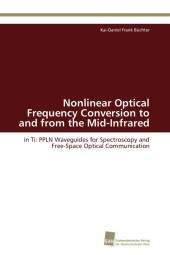 Neuerscheinungen 2011Stand: 2020-01-07 |
Schnellsuche
ISBN/Stichwort/Autor
|
Herderstraße 10
10625 Berlin
Tel.: 030 315 714 16
Fax 030 315 714 14
info@buchspektrum.de |

Kai-Daniel Frank Büchter
Nonlinear Optical Frequency Conversion to and from the Mid-Infrared
in Ti: PPLN Waveguides for Spectroscopy and Free-Space Optical Communication
Aufl. 2011. 132 S. 220 mm
Verlag/Jahr: SÜDWESTDEUTSCHER VERLAG FÜR HOCHSCHULSCHRIFTEN 2011
ISBN: 3-8381-2993-8 (3838129938)
Neue ISBN: 978-3-8381-2993-8 (9783838129938)
Preis und Lieferzeit: Bitte klicken
Mid-infrared (MIR) sources and detectors are of strong interest. Due to a lack of favorable lasers, frequency conversion using nonlinear optical difference-frequency generation (DFG) has been a popular means to generate MIR radiation using near-IR (NIR) sources. On the detector side, optical frequency conversion can be used to realize a hybrid up-conversion detector (UCD). In this case, radiation is converted from the MIR to the NIR or even visible, where detectors with exceptional properties are available. Such devices, based on Ti-indiffused waveguides in periodically poled Lithium Niobate, were investigated. Over 10 mW of tunable radiation at either 3.4 m (3.8 m) were generated, using pump lasers at 1064 nm (1100 nm) and 1550 nm wavelength. Similarly, UCDs based on either DFG or SFG were thoroughly characterized, which convert radiation within a few nm bandwidth around a design wavelength, and can be temperature-tuned by tens of nm. The devices were combined in order to realize free-space optical transmission lines. This way, MIR-spectroscopy of methane was performed with NIR instrumentation only. Also, it was shown that transmission through turbulent channels can be improved.
Daniel Büchter, born in 1981, studied physics at the University of Paderborn from 2002 to 2007. He received his Ph.D. in early 2011 under guidance of Prof. W. Sohler. During the course of his studies, he made use of diverse optical effects in Ti-indiffused waveguides. In April of 2011, he joined an aerospace research institute in Munich.


